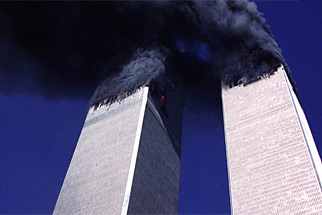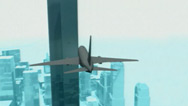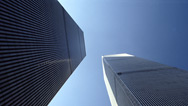Debunking 9/11 Bomb Theories
- Posted 09.05.06
- NOVA
Dr. Shyam Sunder, lead investigator for the National Institute of Standards and Technology, the government body tasked with investigating the Twin Towers' collapse, explains away various conspiracy theories regarding the collapse. In this frank talk with NOVA producer Larry Klein, Sunder discusses why the buildings collapsed in an apparent free fall, why molten metal was seen high on one tower, and what puffs of smoke seen lower in the buildings actually were.
 Listen
Listen
The lead investigator for the U.S. team that studied the Twin Towers' collapse puts the lie to conspiracy theories.
This feature originally appeared on the site for the NOVA program Building on Ground Zero.
Transcript
Debunking 9/11 Bomb Theories
Posted on: August 1, 2006
LARRY KLEIN: Dr. Sunder, thank you very much for being with us here today. Could you give us a brief summary of your agency's final conclusion on how the towers fell?
SHAYM SUNDER: The main reason for the collapse of the buildings were really the impact damage that was caused by the airplanes followed by the dislodged fireproofing and the large multi-floor fires that spread throughout the buildings. The combination of these factors led to the sagging of the floors because of the thermal heat, and the inward bowing of the external columns, which caused the columns to ultimately fail. Because of that failure, the structure below could not resist the forces applied from the top.
LARRY KLEIN: One of the more popular conspiracy theories is based around the speed at which the buildings fell. A lot of people say they must have been imploded, that charges must have been set to make them come down so quickly. Why did the buildings fall so fast?
SHAYM SUNDER: The measurements have indicated that Tower One collapsed in about 11 seconds, and Tower Two collapsed in about 9 seconds. And the argument goes that this is essentially the rate at which free fall would happen. But the building is 70 percent just air in volume, and all of the columns are not solid steel—they are steel boxes in which the thickness of the steel varies from about a quarter inch at the top to about three-quarters of an inch or an inch and a half on the bottom. So they are not by any means solid structural components. But they are properly designed to carry the weight of the steel itself, the weight of the partitions, and the weight of the occupants and the furniture of the building. Those are all things that these structures can withstand very well, but they are not designed to accommodate the failure of, let's say, a 20-floor section in a dynamic impact on the structure below. If it's moving down in a dynamic fashion, the magnitude of the energy unleashed is so large that no structure can withstand that kind of force that is applied. And it essentially came down in free fall.
LARRY KLEIN: Some people look at footage of a kind of yellow or silver molten metal dripping from building two, the south tower, and say that it means that thermite, a chemical used to cut through steel was purposely placed in the building. But what could cause that kind of liquid metal, and why was it the color that it was?
SHAYM SUNDER: Well first of all, this molten liquid that was observed was only observed from one particular spot on the north face of tower two. Which is exactly where a large portion of the airplane fuselage was plowed into a corner along with the building contents. No other place in that building or in at other building did we see any molten liquid come out. So it's a very localized event. What could have caused the color is the aluminum in the airplane, which actually melts at temperatures between 475 and 640 degrees Celsius, combined with partially burned furniture, carpets, partitions, and computers, which were already there. If it were not combined with a solid organic material, you would probably see purely a silvery color of aluminum.
LARRY KLEIN: The one other thing that I know is often pointed out is the puffs of smoke on the lower floors that some say are secondary explosions or bombs being planted to bring them down. What are those puffs of smoke?
SHAYM SUNDER: Well, as I've said, the buildings themselves are really 70 percent or more air. That's where all the tenants work. That's where you have the stairwell enclosures and the space within them. And essentially what happens as the building starts to crumble is that these large voids are suddenly closing, so all that air is being forced out. At the same time, the concrete floor and the gypsum wall partitions which are all grey in color are all being pulverized—as is the furniture and the contents of the building—and this pulverized powder, combined with the air is really thrown out of the building because there's no place for this air to go and you see puffs of smoke which are grayish in color that are ejected pretty much like pistons out on the side as the building comes down. Now, we did see lots of puffs of smoke, and that's not at all very surprising.
LARRY KLEIN: There's been a lot of speculation and questioning about the collapse of World Trade Seven, the other building that fell. And that speculation has been floating around since 9/11, but there's been no official report yet for us or anyone to react to. Why is that?
SHAYM SUNDER: We did issue a preliminary report in June of 2004, but at that point, a significant amount of work from the towers was still left over, and we decided we would assign all our staff to completing the work on the towers, which they did last fall. And since that time, our staff has now re-engaged itself on working on the World Trade Center Seven analysis. We have reviewed 80 boxes of new documents that we received, reviewed subcontractor reports, and we have now established a new process or a new technical approach to model and analyze the various collapse hypotheses for this particular building. In some regards we have to follow where the leads take us, but we expect to complete this work in the spring of next year—early next year.
LARRY KLEIN: So maybe you'll come back and visit us and talk again when your report comes out.
SHAYM SUNDER: Oh, we would be delighted to do so, and update you on what we have found.
LARRY KLEIN: Well, thank you, Dr. Sunder very much—we look forward to the report and again thank you and the staff at NIST for all your hard work. It was really quite an extraordinary study.
SHAYM SUNDER: Thank you for giving me the opportunity.
Credits
Image
- (World Trade Center towers on 9/11)
- © Richard Cohen/CORBIS
Related Links
-

World Trade Center Collapse
Watch an expert-narrated slide show of the Twin Towers' final minutes.
-

Twin Towers of Innovation
A host of engineering marvels distinguished the original World Trade Center.
-

The Structure of Metal
In this interactive, explore metal at the atomic level.
-

A Twin Towers' Survivor Story
Hear one man's extraordinary tale of escape from the South Tower on 9/11.
You need the Flash Player plug-in to view this content.

